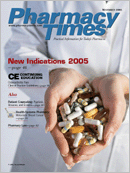Publication
Article
Pharmacy Times
Many New Drug Indications Approved in 2005
Author(s):
This year has seen a great deal of innovation in pharmaceutical products, with more than 50 new drugs approved by the FDA. Also, a number of previously approved agents have received FDA approval for new indications. This article will review some of these new indications for previously approved drugs.
Cardiovascular Drugs
All cardiovascular (CV) agents receiving new indications this year target the renin-angiotensin-aldosterone system (Table 1). Perindopril (Aceon; Solvay) was shown in a large European study to reduce the risk of CV mortality or nonfatal myocardial infarction in patients with stable coronary artery disease but without heart failure.1
Valsartan (Diovan; Novartis) is now indicated for use in patients with left ventricular failure or dysfunction following a heart attack. Previously indicated for hypertension and heart failure in patients intolerant of angiotensinconverting enzyme inhibitors (ACEIs), valsartan now may be used in a wider range of heart failure patients and is no longer limited to patients intolerant of ACEIs. The approval was based on a new analysis of data from a previous trial of angiotensin II receptor blockers and ACEIs in patients who had suffered a heart attack.2
Candesartan (Atacand; AstraZeneca) has been approved for use in patients with left ventricular systolic dysfunction (ie, heart failure) to reduce CV death and heart failure hospitalizations. Atacand may be used in patients already taking ACEIs or alone in patients intolerant of ACEIs.3
Neurologic Drugs
A variety of neurologically active agents received new indications in 2005 (Table 2). Topiramate (Topamax; Ortho-McNeil) now is indicated as monotherapy for patients 10 years of age and older with partial-onset or primary generalized tonic-clonic seizures. The indication is based on a study involving 470 patients. Previously, topiramate was indicated only as adjuvant epilepsy therapy.4
Pregabalin (Lyrica; Pfizer), a compound closely related to gabapentin (Neurontin; Pfizer), received an indication as adjunctive therapy for adult epilepsy patients. The FDA based this decision on data from 3 clinical trials. Until this time, pregabalin had been indicated only for the treatment of patients with diabetic and postherpetic neuropathic pain.5-7
Ropinirole HCl (Requip; Glaxo- SmithKline), a dopamine agonist formerly indicated for Parkinson's disease, is the first and only agent FDA-approved for moderate-to-severe restless legs syndrome. Efficacy was established in 3 trials enrolling a total of >750 patients.8-10
Infectious Disease Drugs
Two agents used to treat infectious disease received additional indications this year (Table 3). Meropenem injection (Merrem IV [intravenous]; Astra- Zeneca) received an indication for the treatment of complicated skin and skin structure infections. A study involving >1000 patients provided the data for the indication.11
Based on 2 trials enrolling >1500 patients, peginterferon alfa-2a (Pegasys; Hoffmann-La Roche) now is indicated for the treatment of patients with chronic hepatitis B who are either hepatitis-B-envelope-antigen-positive or -negative.12,13 The presence of the envelope antigen is a marker of active viral replication.
Rheumatologic Drugs
Two existing agents received additional indications for rheumatologic conditions in 2005 (Table 4). Based on the results of 2 trials,14,15 celecoxib (Celebrex; Pfizer) is now indicated for the relief of signs and symptoms of ankylosing spondylitis, a type of arthritis that affects the spine and sacroiliac joints.
Infliximab (Remicade; Centocor) is a monoclonal antibody that specifically binds to and blocks the action of tumor necrosis factor alpha (a substance involved in the inflammatory processes of the body). Its indication has been expanded to include the treatment of patients with active psoriatic arthritis, based on efficacy in a clinical trial.16
Hormones
Depo-subQ Provera 104 (medroxyprogesterone acetate, Pfizer) is a lower dose, subcutaneous formulation of Depo Provera providing 104 mg/0.65 mL. The dose was chosen after determining that 100 mg was the lowest dose that effectively suppresses ovulation at 91 days. A study enrolling 274 patients demonstrated efficacy in the management of pain associated with endometriosis17 (Table 5).
Dr. Wells is a clinical pharmacist with Cooper Green Hospital in Birmingham, Ala.
For a list of references, send a stamped, self-addressed envelope to: References Department, Attn. A. Stahl, Pharmacy Times, 241 Forsgate Drive, Jamesburg, NJ 08831; or send an e-mail request to: [email protected].







